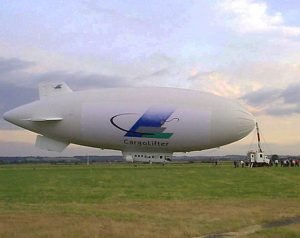

The balance of the buoyancy came from aerodynamic shaping.
Airship transportation system cargolifter full#
to be followed by a visual approach and landing on ground lighting should offer at least as good a standard of weather regularity as is currently achieved by fixed-wing aircraft.The Sky Catamaran, to give it its full name, was a proposed class of hybrid airships obtaining more than half their lift from helium gas.

A blind approach system which will permit a cloud break height of 200 ft. To extend this to blind landing would require an even higher degree of accuracy and reliability, which does not seem to be justified until some actual operational experience of a simpler blind approach system has been gained to establish whether or not there is a real need for blind landing. This paper only deals with the blind approach down to a height of the order of 200 ft. Existing equipment, in particular the Decca Navigation System, can probably meet the case for aerial navigation at altitude, but to fly down an approach to low altitudes into a restricted site demands a higher standard of accuracy and reliability than is offered by any currently available equipment. However, there still remains the problem of navigation, which becomes particularly acute for the final instrument approach. Further developments in ice protection will enable the basic helicopter to be cleared as an airworthy vehicle for all-weather flight. the improvement of helicopter flying qualities so that it is now possible to specify equipment which will enable a helicopter pilot to control his machine in all visibilities and most conditions of turbulence. During the past decade there has been considerable progress in. Any compromise, such as moving the site to the outskirts of the city or only being able to fly in fine weather, will destroy the advantage of the helicopter over other forms of transport. The success of inter-city transport helicopter operation will depend on the ability to fly between small sites in city centres with good regularity. Eight additional shortcomings were noted. Insufficient left directional control in right sideward flight, excessive yaw oscillations in left sideward flight between 15 and 39 knots true airspeed, and excessive pitch and yaw oscillations in rearward flight are also shortcomings. The most significant difference in flying qualities between the OH-58C and the OH-58A was pitch-up tendency at cruise airspeed and aft center of gravity, which is a shortcoming. Activation of this switch during day flight rendered the warning and caution lights unreadable. The possibility of inadvertent activation of the night vision goggle switch located on the pilot cyclic control grip was identified as a deficiency. weight (3200 pounds) and aft center of gravity (fuselage station 112) conditions. Testing was conducted primary at maximum gross. Eighteen flights consisting of 14.7 hours of productive flight test time were flown while conducting a limited handling qualities evaluation of the aircraft. The United States Army Aviation Engineering Flight Activity conducted a Preliminary Airworthiness Evaluation of the OH-58C helicopter from 21 February through 4 March 1978 at Arlington, Texas. The discussion concludes with an examination of modal differences and the development of an airship policy. This paper reviews the current regulatory regime for airworthiness and piloting airships in the United States and Canada.

The regulations for large freight airships have seldom been considered because only one, the ill-fated CargoLifter airship (1995-2002), ever came close to being produced. Many other countries have airships like Germany, the UK, Russia and China, or have teams working on new designs as in Brazil, Portugal and France. New airships are being delivered to the US military that are the largest vehicles since the giant Zeppelins. So few airships exist that the regulations for manufacturing and operating large airships remain either non-prescribed, or are improvised as an extension of regulations designed for airplanes, helicopters or hot air balloons.Īs a new era of transport airships emerges, the number of airships is set to grow exponentially. Approximately 25 airships are inflated and flying at any one time, somewhere in the world.


 0 kommentar(er)
0 kommentar(er)
